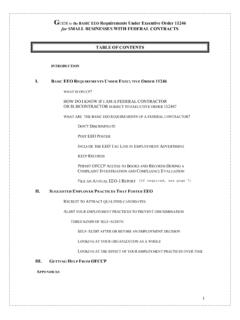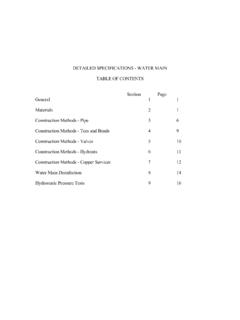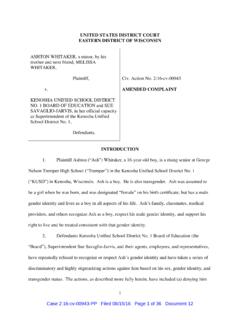Transcription of CHAPTER 14 INTERGOVERNMENTAL COOPERATION …
1 CHAPTER 14 INTERGOVERNMENTAL COOPERATIONELEMENTINTRODUCTIONThe INTERGOVERNMENTAL COOPERATION Element is one (1) of the nine (9) elements of a comprehensive plan required by Section of the Wisconsin Statutes. Section (2) (g) of the Statutes requires this element to compile goals, objectives, policies, programs, and maps for joint planning and decision making between the City of kenosha and other jurisdictions for the siting and building of public facilities and for sharing public services. The Statute also requires this element to: Analyze the relationship of the City and surrounding local governments to each other and to school districts, drainage districts, adjacent County governments, the Region, the State, and to other governmental units (such as lake districts, sanitary districts, and library boards). Incorporate any plans or agreements to which the City of kenosha is a party under Sections , , or of the Statutes.
2 Identify existing or potential conflicts between governmental units and describe the processes to resolve such addition, the following State comprehensive planning goals related to the INTERGOVERNMENTAL COOPERATION Element are set forth in Section of the Statutes and were addressed as part of the planning process:1 Encouragement of coordination and COOPERATION among nearby units of government. Providing adequate infrastructure and public services and an adequate supply of developable land to meet existing and future market demand for residential, commercial, and industrial uses. Providing an integrated, efficient, and economical transportation system that affords mobility, convenience, and safety and that meets the needs of all citizens, including transit-dependent citizens and persons with disabilities. COOPERATION between neighboring and overlapping units of government is one (1) of the goals of the Wisconsin Comprehensive Planning Law and is an important aspect of the City of kenosha Comprehensive Plan.
3 This plan was undertaken as a subset of a cooperative, multi-jurisdictional process that sought to involve all cities, towns, and villages in the County as either full partners or as cooperating partners. The planning process was also fully coordinated with kenosha County, SEWRPC, the Regional Planning Commission serving kenosha County and its communities, and UW-Extension. school districts, environmental and economic development interest groups, and representatives from State agencies were also involved in the planning process through membership on the Multi-Jurisdictional Comprehensive Planning Advisory Committee (MJAC) in the county, or were provided with plan materials and invited to submit comments and/or attend MJAC meetings. In addition, a brainstorming session focusing on existing shared services and agreements among County and local governments and opportunities for INTERGOVERNMENTAL COOPERATION was held at the January 27, 2009 MJAC meeting.
4 1 CHAPTER 1 lists all 14 of the comprehensive planning goals included in Section of the Wisconsin Comprehensive Plan for the City of kenosha : 2035 CHAPTER 14 Page 14 - 2 Some of the benefits of INTERGOVERNMENTAL COOPERATION include: Early Identification of Issues COOPERATION enables jurisdictions to identify and resolve potential conflicts at an early stage, before affected interests have established rigid positions, before the political stakes have been raised, and before issues have become conflicts or crises. Reduced Litigation Communities that cooperate may be able to resolve issues before they become mired in litigation. Reducing the possibility of costly litigation can save a community money, as well as the disappointment and frustration of unwanted outcomes. Consistency COOPERATION can lead to consistency of the goals, objectives, plans, policies, and actions of neighboring communities and other jurisdictions.
5 Understanding As jurisdictions communicate and collaborate on issues of mutual interest, they become more aware of one another s needs and priorities. They can better anticipate problems and work to avoid them through communication and shared information. Trust COOPERATION can lead to positive experiences and results that build trust and good working relationships between jurisdictions. History of SuccessWhen jurisdictions cooperate successfully in one area, the success creates positive feelings and an expectation that other INTERGOVERNMENTAL issues can be resolved as well. Cost SavingsCooperation can save money by increasing efficiency and avoiding unnecessary duplication. COOPERATION can enable services and facilities to be provided that would otherwise be too costly. Examples include shared library services, police and fire protection, emergency medical service, recycling, and shared government buildings.
6 When evaluating shared services, the impact on service levels must be evaluated together with potential cost savings, to ensure that existing levels of service will not be adversely affected and that projected cost savings are likely to be achieved. Address Regional Issues By communicating and coordinating their actions, and working with regional and State agencies, County and local governments are able to address and resolve issues which are regional in nature. Examples include the construction and maintenance of highways, provision of transit service, and planning and construction of facilities for stormwater management, water supply, and sewage treatment and for Considering INTERGOVERNMENTAL COOPERATION The City of kenosha should support further evaluation of consolidating and coordinating services only where the consolidation makes economic sense while not reducing the level or quality of services currently provided to residents.
7 A Comprehensive Plan for the City of kenosha : 2035 CHAPTER 14 Page 14 - 3 Language that identifies consolidation as a goal should only be considered if desired and requested and if the consolidated service is cost effective, that the level and quality of services is not reduced, and the consolidated services do not negatively impact the community s image or character. CHAPTER FormatPart 1 of this CHAPTER includes an analysis of INTERGOVERNMENTAL relationships between the City of kenosha , County, State and Regional government agencies, local governments, adjacent county and other local governments, and special-purpose units of government. Part 2, page 10, describes INTERGOVERNMENTAL agreements involving the City of kenosha and other local governments and identifies existing and potential shared services and agreements, including existing and ongoing cooperative boundary agreements.
8 Part 3, page 14, identifies existing or potential land use conflicts between the City of kenosha and other governmental units, as required by the Statutes, and describes processes to resolve such conflicts. Part 4, page 15, sets forth goals, objectives, policies, and programs intended to guide INTERGOVERNMENTAL COOPERATION efforts through the comprehensive plan design year of 1: ANALYSIS OF INTERGOVERNMENTAL RELATIONSHIPSK enosha CountyAll departments and services provided by kenosha County are available to all residents of the County. The Utilities and Community Facilities Element ( CHAPTER 12) provides a summary of the services and facilities provided by the County. The Transportation Element ( CHAPTER 11) provides information on highway, transit, and other transportation facilities and services provided by kenosha County. This section briefly highlights a few of the County departments that have entered into service agreements with or provide services to the City of kenosha .
9 Planning and Development DepartmentThe Planning and Development Department is comprised of the Planning Operations Division, Long-Range Countywide Planning Division, Land Information Division, UW-Extension, Housing Authority, and Surveying. The Planning and Development Department provides a number of services, including coordination of the multi-jurisdictional comprehensive planning process, GIS mapping services, maintenance of GIS mapping data on the County website and the kenosha Area Land Management (KALM) system. The department also interprets legal descriptions on recorded documents and makes the necessary changes to the real estate assessment roll for assessment and taxation purposes, which is used to generate assessment notices and tax Services DepartmentThe Human Services Department is comprised of Aging and Disability Services, the Brookside Care Center, Children and Family Services, Division of Health, Veteran Services, and Workforce Development.
10 The Human Services Department provides services and enforces public health regulations, including surveillance, investigation, control, and prevention of communicable diseases; other disease prevention; health promotion; human health hazard control; monitoring beach water quality; community safety and well-being; assistance and support to veterans and their families; employment services for low-income families, custodial and non-custodial parents, and the general public; and medical services, emergency shelter, and food for indigent and homeless persons. The Department administers nursing home services via the Brookside Care Center. The Department also prepared the Healthy People kenosha County Annual Report. The Division of Aging and Disability Services, through the kenosha County Aging and Disability Resource Center, provides information, programs, and services pertaining to transportation, healthcare services, housing for the elderly, meal programs, benefit services, financial assistance, recreation and education programs, and other services for the elderly and disabled.















